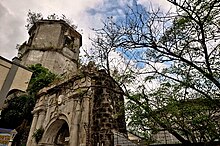Polo Church
| Polo Church | |
|---|---|
| San Diego de Alcala Parish Church | |
| Saint Didacus of Alcala Parish Church | |
 Church facade in 2024 | |
Location in Luzon | |
| 14°42′27″N 120°56′44″E / 14.707444°N 120.945458°E | |
| Location | Valenzuela, Philippines |
| Country | Philippines |
| Denomination | Roman Catholic |
| History | |
| Status | Parish church |
| Dedication | Saint Didacus |
| Architecture | |
| Functional status | Active |
| Architectural type | Church building |
| Style | Baroque |
| Specifications | |
| Materials | adobe bricks |
| Administration | |
| Archdiocese | Manila |
| Diocese | Malolos |
| Clergy | |
| Archbishop | His Eminence José F. Advincula Jr., D.D. |
| Bishop(s) | Most Rev. Dennis C. Villarojo, D.D., Ph.D. |
| Priest(s) | Rev. Fr. Francisco G. Carson |
| Assistant priest(s) | Rev. Fr. John Paul A. Jickain |
San Diego de Alcala Parish Church, colloquially known as Polo Church, is a Roman Catholic church in Valenzuela, located about 15.5 kilometres (9.6 mi) north of Manila in the Philippines. It is under the jurisdiction of the Diocese of Malolos. The original church was the oldest church in the city of Valenzuela, built by Father Juan Taranco and finished by Father Jose Valencia in 1632. Destroyed during World War II, its surviving belfry is the oldest in the city.
History
[edit]This section needs additional citations for verification. (October 2023) |

The Church of San Diego de Alcala in Brgy. Polo in Valenzuela was completed in 1632. Residents were forced into labor to complete the church after the town gained its independence in 1623 from Catangalan through the efforts of Father Juan Taranco and Don Juan Monsod, the barangay head of Polo. The main structure was destroyed by bombs during the Japanese occupation of the Philippines in World War II.[1] The belfry and entrance are the only parts of the four-century old edifice that remain today. They have been preserved by the citizens of Polo (now Valenzuela City).
Bell tower
[edit]
The belfry or bell tower of San Diego de Alcala Church is a cultural and religious relic of the bygone Spanish era. A new church has since been rebuilt and renovated adjacent to the ruins, serving as an aesthetic counterpoint to the largely unchanged tower.[2]
Feast day
[edit]Residents of barangays Polo and Poblacion celebrate the feast day of San Diego de Alcala on November 12 every year. Together with the fiesta, the town also celebrates the "Putong Polo Festival", a food festival honoring the putong Polo, a local variety of the Philippine rice cake puto.[3][4]
Gallery
[edit]- Saint Didacus of Alcala statue
- Stained glass windows
- Church altar and reredos
References
[edit]- ^ "Ecological Profile: 2021" (PDF). City Government of Valenzuela. p. V, 230. Archived from the original (PDF) on November 6, 2023. Retrieved November 6, 2023.
- ^ San Diego de Alacala Church "Landmarks". Valenzuelako, Official Website of Valenzuela. Retrieved on March 6, 2013.
- ^ Catapat, Willie (November 14, 2009). "Polo fiesta Valenzuela's grandest". Manila Bulletin. Retrieved January 7, 2012.
- ^ "Putong Polo Festival". Travel the Philippine Islands. Retrieved on March 6, 2013.
External links
[edit] Media related to Saint Didacus of Alcalá Church (Valenzuela City) at Wikimedia Commons
Media related to Saint Didacus of Alcalá Church (Valenzuela City) at Wikimedia Commons- Polo Church on Facebook


 French
French Deutsch
Deutsch









